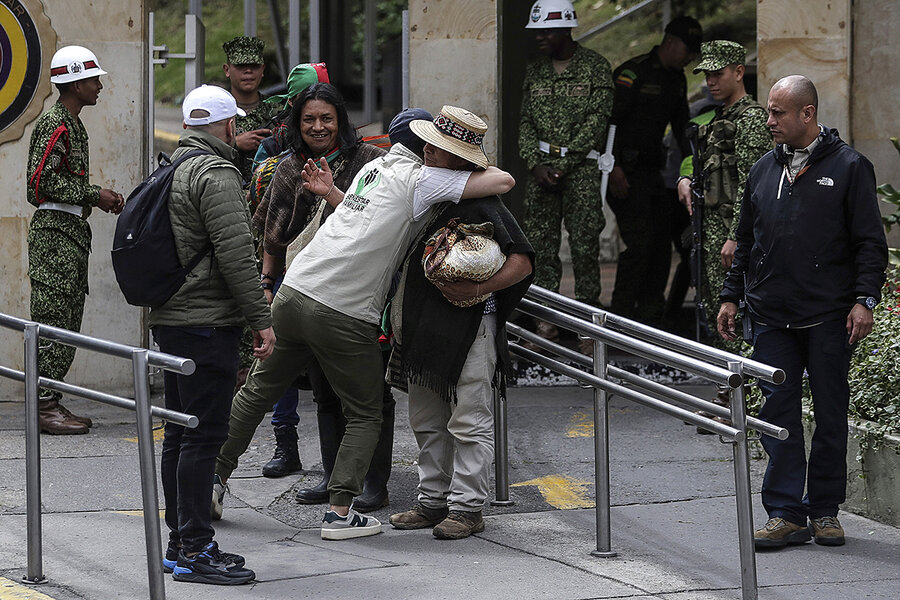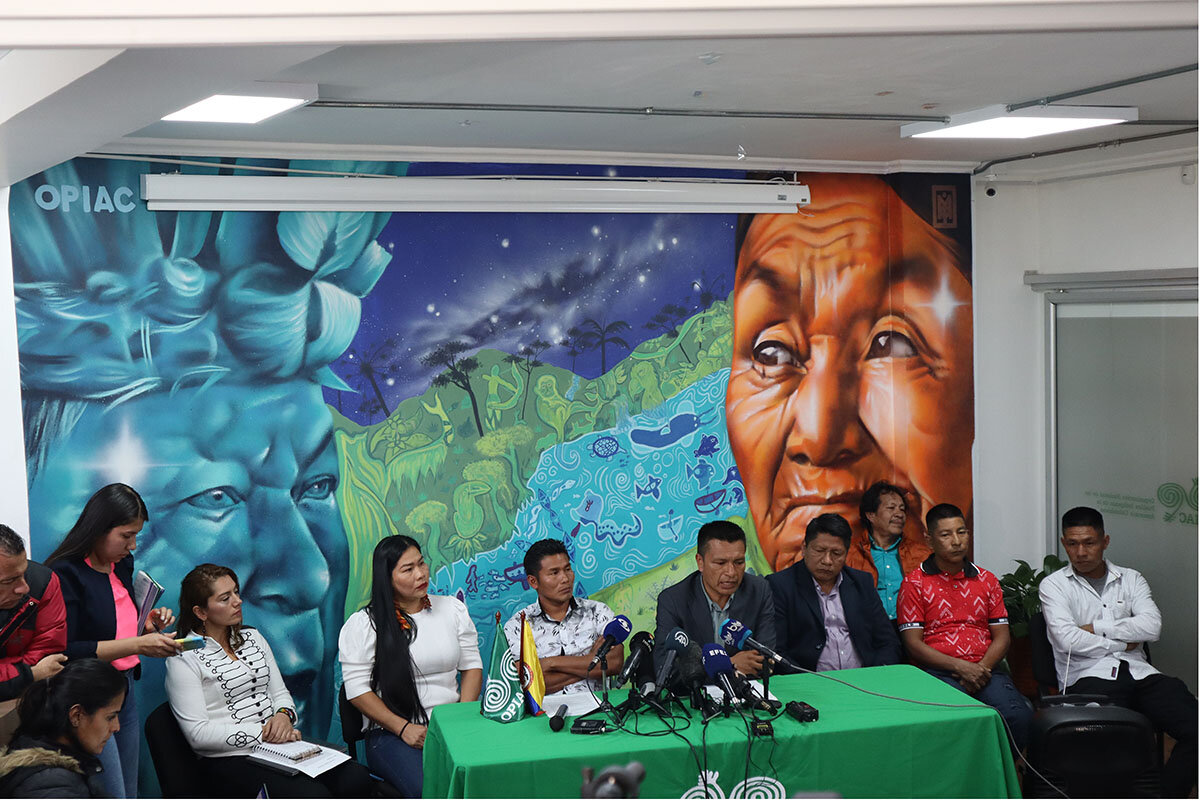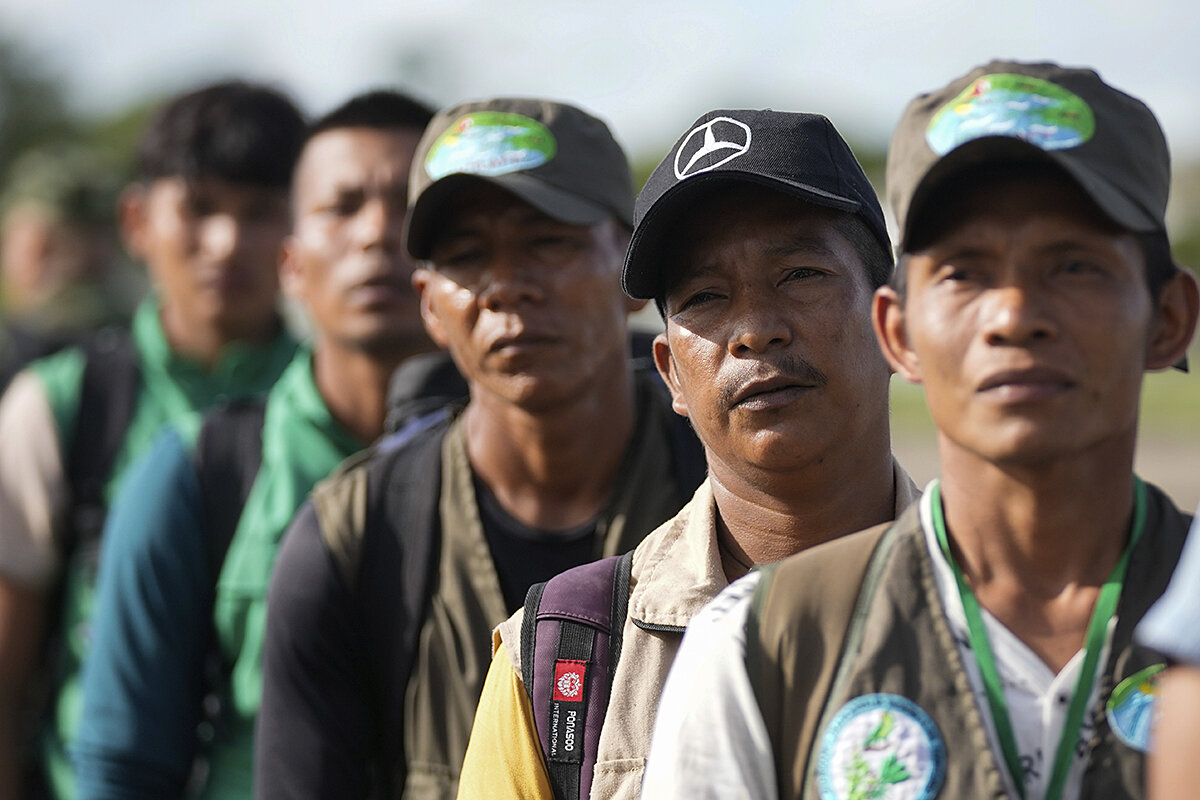Legacy of jungle rescue of lost children? Indigenous collaboration.
Loading...
| BOGOTÁ, Colombia
Few things have united the Colombian population like the recent successful rescue of four young Indigenous children following a deadly plane crash – and their ability to survive alone in the jungle for 40 days.
The story of Lesly Jacobombaire Mucutuy, Soleiny Jacobombaire Mucutuy, Tien Ranoque Mucutuy, and Cristin Ranoque Mucutuy, who ranged in age from 11 months to 13 years at the time of the crash, grabbed hearts and headlines this month for their incredible resilience. The plane wreck killed all three adults on board, but against great odds the children survived alone in the jungle by tapping into ancestral education about the animals, edible plants, and survival tactics in the wild jungle.
Their survival is an inspiration, but the saga also put a spotlight on challenges faced by Colombia’s Indigenous populations, who fight to preserve their culture amid historical marginalization. In 2021, Colombia had the highest share of Indigenous people living in poverty of any Latin American country.
Why We Wrote This
A story focused onThe incredible story of four young children surviving in the Colombian jungle this month is only part of the good news. The close coordination between the armed forces and Indigenous volunteers could serve as a model for cooperation in the future.
A promising thread has emerged in the days since the children’s discovery, which is the unparalleled, collaborative search efforts by the Colombian military and Indigenous guards that led to their rescue in the first place. It has many here looking to what the future of respect and partnership might look like between the government and Indigenous communities.
“This was a lesson ... to look for commonalities” between the government and Indigenous groups, says Rufina Román, a leader in the National Organization of Indigenous People of the Colombian Amazon, a nongovernmental organization. “We are going to need to rely on joint action for many other issues [beyond this plane crash] that come at us, like climate change” and environmental protection, she says.
“It’s proof that coordinated actions are needed for the common good.”
“Special capacity”
On May 15, two weeks after an engine failure caused a flight carrying three adults and the four children to crash in the dense Amazon jungle, rescuers found the front part of the plane stuck between trees in the southern Colombian state of Caquetá. The pilot, an Indigenous leader, and the children’s mother were found dead.
Although the search team saw signs of life – a baby bottle, half-eaten fruit, and dirty diapers – the children were nowhere to be found.
The Colombian government deployed search-and-rescue planes and helicopters, as well as land and river teams to the crash site. They scoured for the kids in an area of about 1,650 miles and used sound systems to play a recording of the children’s grandmother speaking in their native language, Huitoto, telling them that people were looking for them and that they should stay in one place.
The children kept moving, some close to them speculate out of fear of who exactly was looking for them. Armed dissident guerrilla groups are a threat for many Indigenous communities in the jungle.
But even so, the search was challenging from the start.
“It’s a very remote zone that requires special capacity,” says Pedro Sánchez, the general who led the government search operation. Some 16 hours of rain a day, humidity, dense vegetation, and dangerous animals make the terrain hard to penetrate even for the country’s best-trained soldiers. It’s hopeless trying to see anything from the air due to tree coverage, and it’s hard from the ground, too. “It’s impossible to see more than 20 meters ahead,” General Sánchez says.
Eventually, General Sánchez authorized Indigenous volunteers from across the country to participate in the operation: a decision that almost certainly saved the children’s lives.
“Without them, we still wouldn’t have found the kids,” he says of the approximately 80 Indigenous volunteers.
Working with the guard helped multiply eyes and ears on the ground, but also contributed important, deep-seated knowledge about the jungle. Spiritual knowledge, too, General Sánchez says.
He describes the collaboration as “very fluid,” which stands in contrast to the historical mistrust between Indigenous people and the government’s armed forces. Indigenous communities are often stigmatized as uneducated, violent, and out of touch with modern society. And the absence of the state in many of these remote communities, lack of public services like roads and running water or electricity, and few security measures in a region overrun by armed groups mean that many mistrust and feel abandoned by the state.
The family on the felled flight is part of the Huitoto Indigenous community, one of more than 87 officially recognized Indigenous groups in Colombia. Their small community, and the broader Caquetá region, has suffered decades of violence at the hands of armed groups – and the government.
“Part of their vulnerability is they’re isolated to begin with,” says Oliver Kaplan, associate professor in international relations and human rights at the University of Denver. “To connect with the rest of the country is extremely difficult.”
Changing perceptions
There’s hope that the unprecedented collaboration that took place between the armed forces and the Indigenous guard in Operation Hope, as the rescue mission was dubbed, can blaze a new path for relations between the government and Indigenous groups here.
When the soldiers and Indigenous guards were deep in the jungle, on several occasions their technology, like GPS satellites and compasses, stopped working. “What do you say?” General Sánchez asked the Indigenous guards.
That simple question was “something spectacular,” says Janer Quina, regional coordinator of the Indigenous guard in Cauca and a member of the Nasa (also known as the Paéz) community, who participated in the search. It contrasts with his experience with non-Indigenous Colombians in the past. Historical knowledge around nature, for example, is often met with skepticism from outsiders, he says. “A big part of the country will not believe what happens in the jungle.”
In the long, emotional search, the soldiers and Indigenous guards shared food, personal questions, and survival techniques. Indigenous guards shared ancestral knowledge, like medicinal plants, while soldiers taught them to use their high-tech equipment.
“They changed their perception of us,” Mr. Quina says.
Learning young
What was perhaps even more surprising was the kids’ ability to survive in such precarious conditions.
“We taught them how to survive in the Amazon jungle,” says Eliecer Muñoz, one of the Indigenous rescuers, of the education that children in many remote Indigenous communities are brought up with about plants, animals, and how to construct a shelter.
Ms. Román, who grew up Huitoto like the kids, says the capacity to survive is developed early on – starting in the mother’s womb. When kids play, they imitate adult life: Instead of dolls, parents might give their children a knife to peel a cassava root, she says. Thus, “Lesly [the 13-year-old] knew what to do,” says Ms. Román, including which plants or insects were edible and how to care for a baby without any of the tools many Westerners rely on, like formula or a crib.
The successful mission, and the shared responsibility between the military and the volunteers, signifies the possibility of a more constructive relationship between these groups down the line, says Mr. Kaplan. “It’s inspiring. It shows that understanding and respect are possible.”
At a news conference in Bogotá last week, Indigenous leaders said there’s a need to guarantee basic rights for Colombia’s Indigenous people. “We hope for more state presence via social programs,” says Ms. Román, “but recognizing our own Indigenous systems as well.”
Colombians have been invited by President Gustavo Petro to celebrate the four outstanding children and approximately 200 responders on June 24.
It’s moving to get so much praise and appreciation for the importance and power of Indigenous know-how, says Mr. Quina. Although there’s still a long way to go for Indigenous rights and respect for the diverse heritage and tradition here, the national unity around the rescue is a good start, he says. “Our Indigenous guards have demonstrated the flip side of how the world usually characterizes us.”








